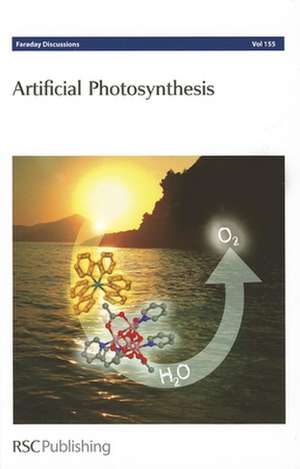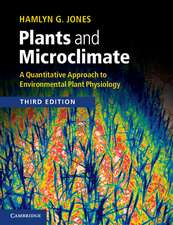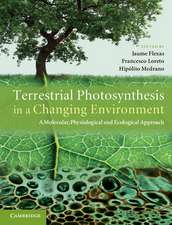Artificial Photosynthesis: Faraday Discussions No 155: Faraday Discussions, cartea 155
Autor Royal Society of Chemistryen Limba Engleză Hardback – 31 ian 2012
This volume focuses on possible solutions to long-standing problems in the development of artificial synthesis. These answers will not be easy to find and some highly innovative research is called for. Considerable progress has been made in understanding the fine details of natural photosynthesis and there has been an emergence and growth of nanotechnology. This discussion will look at applying new knowledge to the old problems. There is a growing conviction that the only real prospect for our long-term energy provision relies on the ability to collect and store sunlight in the form of chemical potential. The creation of artificial systems to exploit the basic chemistry of photosynthesis to produce hydrogen or other fuels is a concept that crops up each time there is an escalation in the price of oil. In addition, we need to mop up the excess carbon dioxide left over from our present era of profligate fossil fuel consumption. The net result is an upsurge in the urgency to design effective artificial photosynthetic systems. This is a global problem which grows more important on a daily basis and it will soon become the dominant scientific issue. The researchers who were highly active in the 1970s and early 1980s - a period that witnessed the great boom in solar energy research - will soon be lost and there is a real danger of future generations reinventing the wheel. It seems critical that this expertise is passed on to new researchers, with a need to focus on possible solutions to long-standing problems. This topical and important area of science covers many disciplines. The combination of biology, chemistry, physics and theory makes for an exciting blend of discussion points In this volume the topics covered include: Electronic energy transfer Fuel production / carbon dioxide reduction Oxygen evolution Integrated photo-systems Electron transfer
| Toate formatele și edițiile | Preț | Express |
|---|---|---|
| Hardback (2) | 1232.50 lei 3-5 săpt. | |
| Royal Society Of Chemistry – 31 ian 2012 | 1232.50 lei 3-5 săpt. | |
| Royal Society Of Chemistry – 15 iun 2017 | 1324.68 lei 3-5 săpt. |
Din seria Faraday Discussions
- 14%
 Preț: 1314.30 lei
Preț: 1314.30 lei - 14%
 Preț: 1316.41 lei
Preț: 1316.41 lei - 14%
 Preț: 1310.15 lei
Preț: 1310.15 lei - 14%
 Preț: 1318.04 lei
Preț: 1318.04 lei - 9%
 Preț: 1179.23 lei
Preț: 1179.23 lei - 14%
 Preț: 1332.98 lei
Preț: 1332.98 lei - 14%
 Preț: 1321.37 lei
Preț: 1321.37 lei - 14%
 Preț: 1326.33 lei
Preț: 1326.33 lei - 14%
 Preț: 1308.50 lei
Preț: 1308.50 lei - 14%
 Preț: 1290.29 lei
Preț: 1290.29 lei - 14%
 Preț: 1323.05 lei
Preț: 1323.05 lei - 14%
 Preț: 1301.86 lei
Preț: 1301.86 lei - 14%
 Preț: 1305.19 lei
Preț: 1305.19 lei - 14%
 Preț: 1321.37 lei
Preț: 1321.37 lei - 14%
 Preț: 1328.01 lei
Preț: 1328.01 lei - 14%
 Preț: 1319.72 lei
Preț: 1319.72 lei - 14%
 Preț: 1310.15 lei
Preț: 1310.15 lei - 14%
 Preț: 1329.65 lei
Preț: 1329.65 lei - 14%
 Preț: 1306.02 lei
Preț: 1306.02 lei - 14%
 Preț: 1324.68 lei
Preț: 1324.68 lei - 14%
 Preț: 1326.33 lei
Preț: 1326.33 lei - 9%
 Preț: 1180.17 lei
Preț: 1180.17 lei - 14%
 Preț: 1311.83 lei
Preț: 1311.83 lei - 14%
 Preț: 1604.94 lei
Preț: 1604.94 lei - 14%
 Preț: 1237.50 lei
Preț: 1237.50 lei - 14%
 Preț: 1241.29 lei
Preț: 1241.29 lei - 14%
 Preț: 1241.29 lei
Preț: 1241.29 lei - 14%
 Preț: 1242.60 lei
Preț: 1242.60 lei - 14%
 Preț: 1241.29 lei
Preț: 1241.29 lei - 14%
 Preț: 1278.64 lei
Preț: 1278.64 lei - 14%
 Preț: 1288.89 lei
Preț: 1288.89 lei - 14%
 Preț: 1277.65 lei
Preț: 1277.65 lei - 14%
 Preț: 1285.76 lei
Preț: 1285.76 lei - 14%
 Preț: 1279.49 lei
Preț: 1279.49 lei - 14%
 Preț: 1287.25 lei
Preț: 1287.25 lei - 14%
 Preț: 1451.41 lei
Preț: 1451.41 lei - 14%
 Preț: 1291.06 lei
Preț: 1291.06 lei - 14%
 Preț: 1328.01 lei
Preț: 1328.01 lei - 14%
 Preț: 1321.37 lei
Preț: 1321.37 lei - 14%
 Preț: 1318.04 lei
Preț: 1318.04 lei - 14%
 Preț: 1316.41 lei
Preț: 1316.41 lei - 14%
 Preț: 1309.80 lei
Preț: 1309.80 lei - 14%
 Preț: 1318.04 lei
Preț: 1318.04 lei - 14%
 Preț: 1323.05 lei
Preț: 1323.05 lei - 14%
 Preț: 1319.72 lei
Preț: 1319.72 lei - 14%
 Preț: 1323.05 lei
Preț: 1323.05 lei - 14%
 Preț: 1321.37 lei
Preț: 1321.37 lei - 14%
 Preț: 1321.37 lei
Preț: 1321.37 lei - 14%
 Preț: 1323.05 lei
Preț: 1323.05 lei
Preț: 1232.50 lei
Preț vechi: 1433.15 lei
-14% Nou
Puncte Express: 1849
Preț estimativ în valută:
235.87€ • 245.34$ • 194.72£
235.87€ • 245.34$ • 194.72£
Carte disponibilă
Livrare economică 22 martie-05 aprilie
Preluare comenzi: 021 569.72.76
Specificații
ISBN-13: 9781849734462
ISBN-10: 1849734461
Pagini: 250
Dimensiuni: 148 x 252 x 26 mm
Greutate: 0.69 kg
Editura: Royal Society Of Chemistry
Seria Faraday Discussions
ISBN-10: 1849734461
Pagini: 250
Dimensiuni: 148 x 252 x 26 mm
Greutate: 0.69 kg
Editura: Royal Society Of Chemistry
Seria Faraday Discussions
Notă biografică
Faraday Discussions documents a long-established series of Faraday Discussion meetings which provide a unique international forum for the exchange of views and newly acquired results in developing areas of physical chemistry, biophysical chemistry and chemical physics.
Textul de pe ultima copertă
Faraday Discussion 155 This volume focuses on possible solutions to long-standing problems in the development of artificial synthesis. These answers will not be easy to find and some highly innovative research is called for. Considerable progress has been made in understanding the fine details of natural photosynthesis and there has been an emergence and growth of nanotechnology. This discussion will look at applying new knowledge to the old problems. There is a growing conviction that the only real prospect for our long-term energy provision relies on the ability to collect and store sunlight in the form of chemical potential. The creation of artificial systems to exploit the basic chemistry of photosynthesis to produce hydrogen or other fuels is a concept that crops up each time there is an escalation in the price of oil. In addition, we need to mop up the excess carbon dioxide left over from our present era of profligate fossil fuel consumption. The net result is an upsurge in the urgency to design effective artificial photosynthetic systems. This is a global problem which grows more important on a daily basis and it will soon become the dominant scientific issue. The researchers who were highly active in the 1970s and early 1980s - a period that witnessed the great boom in solar energy research - will soon be lost and there is a real danger of future generations reinventing the wheel. It seems critical that this expertise is passed on to new researchers, with a need to focus on possible solutions to long-standing problems. This topical and important area of science covers many disciplines. The combination of biology, chemistry, physics and theory makes for an exciting blend of discussion points In this volume the topics covered include: " Electronic energy transfer " Fuel production / carbon dioxide reduction " Oxygen evolution " Integrated photo-systems " Electron transfer
Cuprins
Introductory Lecture: Realizing Artificla Photosynthesis; Papers and Discussions; Design principles of photosynthetic light-harvesting; Physical constraints on charge transport through bacterial nanowires; Engineering antiparallel charge-transfer cascades into supramolecular n/p-heterojunction photosystems: Toward directional self-sorting on surfaces; Synthetic polymers for solar harvesting; Formation of a long-lived electron-transfer state of a naphthalene-quinolinium ion dyad and the p-dimer radical cation; General Discussion; Development of highly efficient supramolecular CO2 reduction photocatalysts with high turnover frequency and durability; Steric effect for proton, hydrogen-atom, and hydride transfer reactions with geometric isomers of NADH-model ruthenium complexes; How is the water molecule activated on metalloporphyrins? Oxygenation of substrates induced through one-photon/two-electron conversion in artificial photosynthesis by visible light; Electron transfer kinetics in water splitting dye-sensitized solar cells based on core-shell oxide electrodes; Light-driven water oxidation with a molecular tetra-cobalt(III) cubane cluster; Colloidal metal oxide particles loaded with synthetic catalysts for solar H2 production; A Ga2O3 underlayer as an isomorphic template for ultrathin hematite films toward efficient photoelectrochemical water splitting; Accumulative electron transfer: Multiple charge separation in artificial photosynthesis; Decorating polyelectrolyte wrapped SWNTs with CdTe quantum dots for solar energy conversion; Ru complexes containing pyridine dicarboxylate ligands: electronic effects on their catalytic activity toward water oxidation; Single-molecule fluorescence dynamics of a butadiyne-linked porphyrin dimer: the effect of conformational flexibility in host polymers; Artificial leaf device for solar fuel production; General discussion; Kinetics of light-driven oxygen evolution at a-Fe2O3 electrodes; Photoinduced electron transfer in composites of conjugated polymers and dendrimers with branched colloidal nanoparticles; Excitons and charges at organic semiconductor heterojunctions; General Discussion; Concluding remakrs; Additional Information; Poster Titles; List of Participants; Index of Contributors
Descriere
This volume focuses on possible solutions to long-standing problems in the development of artificial synthesis.









